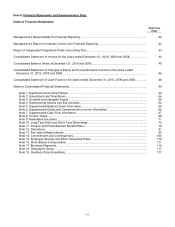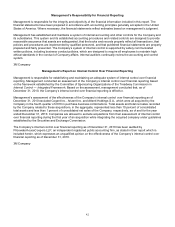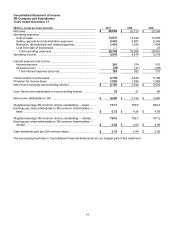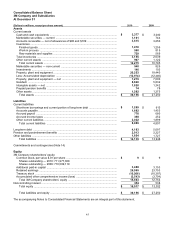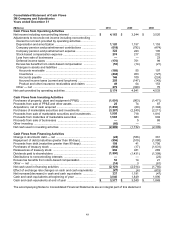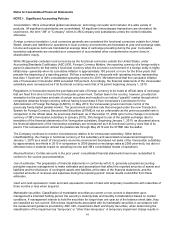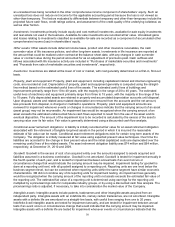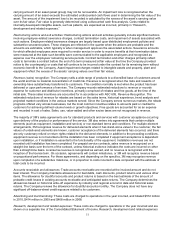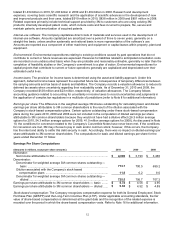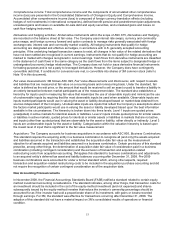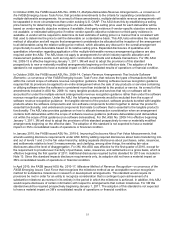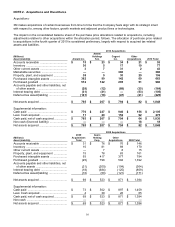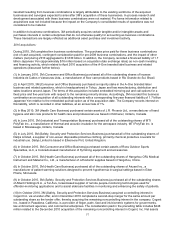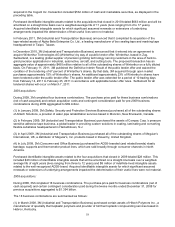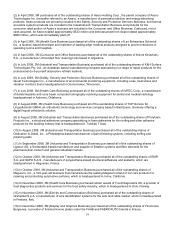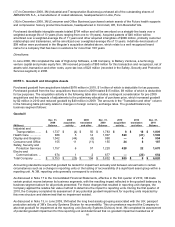3M 2010 Annual Report Download - page 57
Download and view the complete annual report
Please find page 57 of the 2010 3M annual report below. You can navigate through the pages in the report by either clicking on the pages listed below, or by using the keyword search tool below to find specific information within the annual report.51
carrying amount of an asset (asset group) may not be recoverable. An impairment loss is recognized when the
carrying amount of an asset exceeds the estimated undiscounted cash flows used in determining the fair value of the
asset. The amount of the impairment loss to be recorded is calculated by the excess of the asset’s carrying value
over its fair value. Fair value is generally determined using a discounted cash flow analysis. Costs related to
internally developed intangible assets, such as patents, are expensed as incurred, primarily in “Research,
development and related expenses.”
Restructuring actions and exit activities: Restructuring actions and exit activities generally include significant actions
involving employee-related severance charges, contract termination costs, and impairment of assets associated with
such actions. Employee-related severance charges are largely based upon distributed employment policies and
substantive severance plans. These charges are reflected in the quarter when the actions are probable and the
amounts are estimable, which typically is when management approves the associated actions. Severance amounts
for which affected employees were required to render service in order to receive benefits at their termination dates
were measured at the date such benefits were communicated to the applicable employees and recognized as
expense over the employees’ remaining service periods. Contract termination and other charges primarily reflect
costs to terminate a contract before the end of its term (measured at fair value at the time the Company provided
notice to the counterparty) or costs that will continue to be incurred under the contract for its remaining term without
economic benefit to the Company. Asset impairment charges related to intangible assets and property, plant and
equipment reflect the excess of the assets’ carrying values over their fair values.
Revenue (sales) recognition: The Company sells a wide range of products to a diversified base of customers around
the world and has no material concentration of credit risk. Revenue is recognized when the risks and rewards of
ownership have substantively transferred to customers. This condition normally is met when the product has been
delivered or upon performance of services. The Company records estimated reductions to revenue or records
expense for customer and distributor incentives, primarily comprised of rebates and free goods, at the time of the
initial sale. These sales incentives are accounted for in accordance with ASC 605, Revenue Recognition. The
estimated reductions of revenue for rebates are based on the sales terms, historical experience, trend analysis and
projected market conditions in the various markets served. Since the Company serves numerous markets, the rebate
programs offered vary across businesses, but the most common incentive relates to amounts paid or credited to
customers for achieving defined volume levels or growth objectives. Free goods are accounted for as an expense
and recorded in cost of sales. Sales, use, value-added and other excise taxes are not recognized in revenue.
The majority of 3M’s sales agreements are for standard products and services with customer acceptance occurring
upon delivery of the product or performance of the service. 3M also enters into agreements that contain multiple
elements (such as equipment, installation and service) or non-standard terms and conditions. For multiple-element
arrangements, 3M recognizes revenue for delivered elements when it has stand-alone value to the customer, the fair
values of undelivered elements are known, customer acceptance of the delivered elements has occurred, and there
are only customary refund or return rights related to the delivered elements. In addition to the preceding conditions,
equipment revenue is not recorded until the installation has been completed if equipment acceptance is dependent
upon installation, or if installation is essential to the functionality of the equipment. Installation revenues are not
recorded until installation has been completed. For prepaid service contracts, sales revenue is recognized on a
straight-line basis over the term of the contract, unless historical evidence indicates the costs are incurred on other
than a straight-line basis. License fee revenue is recognized as earned, and no revenue is recognized until the
inception of the license term. On occasion, agreements will contain milestones, or 3M will recognize revenue based
on proportional performance. For these agreements, and depending on the specifics, 3M may recognize revenue
upon completion of a substantive milestone, or in proportion to costs incurred to date compared with the estimate of
total costs to be incurred.
Accounts receivable and allowances: Trade accounts receivable are recorded at the invoiced amount and do not
bear interest. The Company maintains allowances for bad debts, cash discounts, product returns and various other
items. The allowance for doubtful accounts and product returns is based on the best estimate of the amount of
probable credit losses in existing accounts receivable and anticipated sales returns. The Company determines the
allowances based on historical write-off experience by industry and regional economic data and historical sales
returns. The Company reviews the allowance for doubtful accounts monthly. The Company does not have any
significant off-balance-sheet credit exposure related to its customers.
Advertising and merchandising: These costs are charged to operations in the year incurred, and totaled $512 million
in 2010, $414 million in 2009 and $468 million in 2008.
Research, development and related expenses: These costs are charged to operations in the year incurred and are
shown on a separate line of the Consolidated Statement of Income. Research, development and related expenses


